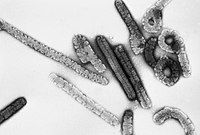
Photo from wikipedia
&NA; Hemorrhagic enteritis (HE) is an acute viral disease that affects avian species, particularly turkeys, compromising their commercial production and having a negative effect on animal welfare. Turkey adenovirus 3… Click to show full abstract
&NA; Hemorrhagic enteritis (HE) is an acute viral disease that affects avian species, particularly turkeys, compromising their commercial production and having a negative effect on animal welfare. Turkey adenovirus 3 (TAdV‐3), is the main causal agent of the disease. In this study, we considered 3 groups of turkeys to achieve 2 purposes: 1) A preliminary investigation on the microbiota content in the 4 parts of healthy turkey's intestine (group A), namely duodenum, jejunum, ileum, and ceca was done; 2) an investigation on the relationship between natural infections with TAdV‐3 and the intestinal microbiota in the jejunum, where HE mostly develops, comparing group A with animals with molecular positivity for the virus and with clinical signs of HE (group B) and animals with molecular positivity for the virus but without clinical signs (group C). Massive sequencing of the hypervariable V1‐V2 regions of 16S rRNA gene and QIIME 1.9.1 software analysis was performed, and operation taxonomic units (OTUs) were classified into 4 abundant phyla: Actinobacteria, Bacteroidetes, Firmicutes, and Proteobacteria. The microbial population of small intestine was distributed almost homogeneously in the healthy turkeys, and Firmicutes was the prevalent phylum (79.85% in duodenum, 89.57% in jejunum and 99.28% in ileum). As compared with small intestine, ceca microbial community was much more heterogeneous: Firmicutes (48.03%), Bacteroidetes (33.60%) and Proteobacteria (12.32%). In the natural infections of HEV, the main bacterial families were Bacteroidaceae (Bacteroidetes) and Peptostreptococcaceae (Firmicutes), uniquely detected in group B and C. Also Clostridiaceae (Firmicutes) was detected, uniquely in group B.
Journal Title: Poultry Science
Year Published: 2017
Link to full text (if available)
Share on Social Media: Sign Up to like & get
recommendations!